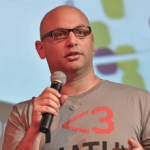The Crowdstorm Effect: Recruiting Crowds – How GE, LEGO, Starbucks Succeed When Others Fail
 How GE, LEGO, Starbucks and Quirky Succeed Where Others Have Failed
How GE, LEGO, Starbucks and Quirky Succeed Where Others Have Failed
When we think about recruiting for crowdstorm projects, we’re starting a journey that is analogous to what organizations do when they market a new product or service. The recruiting process must build awareness, position the challenge so people will consider participating, and navigate participants through to actually joining — the way a consumer evaluates a product purchase.
For Search patterns, we need to target participants with domain knowledge — we want to find the people who will find our problem trivial. They can come from existing communities (e.g. industry groups, or crowdsourcing platforms such as Innocentive, jovoto and many others) or groups we want to reach (e.g. specific interest groups, groups from related fields, universities).
For Collaborative patterns, our target audience can broaden substantially depending on the goal of the challenge. In the GE example described in Part 1, the target was not only talent capable of coming up with new ideas for power grid technology; it also included participants who were interested in sustainability and energy policy issues as well as the general public who wanted to follow, and potentially help evaluate, the results.
Recruiting for crowdstorms requires developing content to build awareness and defining the delivery mechanisms to capture the attention of target groups similar to a product launch. We need something for participants to interact with: content to market (e.g. written, video, etc) and the mechanisms to deliver (web site, existing media, social media, etc).
To help with this, many organizations have turned to partners. Coalitions are important in sharing various responsibilities for delivering successful open crowdstorm challenges. While GE used VCs to help with incentives, other organizations have partnered with media outlets to help them get the message out about a challenge. When Starbucks ran its Betacup challenge to reduce paper cup waste, it partnered with Core77, a media company that has an existing product design community of over 200,000; other partners included Denuo, Good Day Monsters, Instructables, and Threadless — all had communities or were media outlets that could help make the challenge known to a wide community. From this core, other prominent media outlets — the New York Times, Fast Company, Good, The Independent, Mashable, Cnet, PSFK — picked up the story and brought it to the attention of a wider audience. By the end of the challenge, the Betacup had 10 million media impressions — powerful not only for recruiting at the beginning of the challenge but throughout its duration.
In both the Search and Collaborative patterns the call to action and incentives provide the basis for participant consideration. Once participants join and experience the challenge in the Search pattern, the contest becomes a transaction: ideas are submitted, experts evaluate them, and awards are administered. In the Collaborative pattern, we see a more complex value exchange.
LEGO Cuusoo is a good example of a collaborative crowdstorm. It is not so much a contest as it is a collective filter. As in the Search pattern, people or teams pitch ideas. But for the LEGO team to consider an idea it must have the support of 10,000 participants. And the community also offers feedback on possible refinements to help submitters increase their chances of success. Because the user experience is good – participants feel their voice is heard, they are making an impact – they are likely to return. And, they become recruiters for LEGO’s innovation process, similar to how customers who have tried a product become the best advocates.
At start-ups like Quirky, the recruiting and the engagement process are even more closely aligned. Crowds play roles throughout the creation, design and marketing processes. Participation is measured across all activities and rewarded. The crowd’s interaction with Quirky is approaching that of employees. The forums in the Quirky community reflect this. There you find lively debates on everything from compensation to recruiting. Their crowds are not just helping to produce products and services, they are helping them to get better at working with crowds, too.
At this level of engagement with crowds, the role of community management and improved measurement becomes crucial.
We look forward to discussing these two important functions in future posts. You can click here for other articles in this series.
image credit: insidemonkey.com
Wait! Before you go…
Choose how you want the latest innovation content delivered to you:
- Daily — RSS Feed — Email — Twitter — Facebook — Linkedin Today
- Weekly — Email Newsletter — Free Magazine — Linkedin Group
Peter Ryder is co-author of Crowdstorm: The Future of Innovation, Ideas and Problem Solving (Wiley). He has had a successful career with Deloitte, CSC, and Accenture helping organizations use technology to transform their operations. Today he works as an investor and advisor.
is co-author of Crowdstorm: The Future of Innovation, Ideas and Problem Solving (Wiley). He has had a successful career with Deloitte, CSC, and Accenture helping organizations use technology to transform their operations. Today he works as an investor and advisor.
 Shaun Abrahamson is co-author of Crowdstorm: The Future of Innovation, Ideas and Problem Solving (Wiley). Shaun was an early stage investor and advisor with MIT Computer Aided Design Lab and the Berlin School of Creative Leadership. Today he is Co-founder & Managing Partner at Urban.Us and an Advisor to Future of Urban Development & Services Initiative, World Economic Forum/
Shaun Abrahamson is co-author of Crowdstorm: The Future of Innovation, Ideas and Problem Solving (Wiley). Shaun was an early stage investor and advisor with MIT Computer Aided Design Lab and the Berlin School of Creative Leadership. Today he is Co-founder & Managing Partner at Urban.Us and an Advisor to Future of Urban Development & Services Initiative, World Economic Forum/
NEVER MISS ANOTHER NEWSLETTER!
LATEST BLOGS
What happened to smart advertising?
For a television advertisement to be effective, do you need to lay out everything for the viewer and make it obvious? Or, is an advertisement more memorable if you let the viewer connect the dots themselves? Here are two examples of television advertisements that promote the product in a slightly more intellectual/emotional way that promotes engagement and curiousity:
Read MoreInvention versus Innovation
Continuous innovation requires that innovation is placed at the center of the organization and that all parts of the organization are changed to support it. To effectively place innovation at the center of the organization, people must know what innovation is, what it looks like in their organization, and how they can contribute. Most people easily confuse invention with innovation, and wrongly chase invention in the name of innovation.
Read More




I went to Quirky web site and was very impressive with their progress.
Especially, I was impressed because I had similar ideas.
I still have some posts on my blog on this topic.
Anyway, it’s easy for me to develop and present business model that by nature will be much more advance and radical even comparing to Quirky’s business model. And I’d like to develop and polish this business model using some kind of crowdsourcing platform. What option I have in this regard?
By the way, for some reason no one is providing service – crowdsourcing of business model.
So, can I have your insight on this topic?
If you just promote your book or your business, feel free do not response to my question.